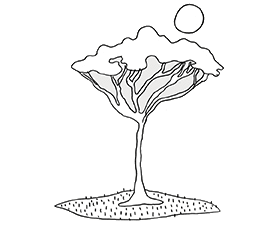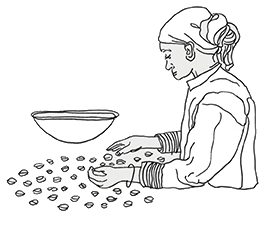About Gachatha AB
Gachatha Coffee Factory rests on a 392-acre piece of land between the villages of Muthuaini, Thiriku, Gachenge, and Kianjau. It started in 1963 and its current members stand at 1,542.
The factory treats all wastewater in soaking pits to ensure no contaminates run into the local waterways, which are a source for drinking water. The community also places great importance on protecting the indigenous trees that remain in the area, so that the local bird life remains intact.
The main varieties of coffee grown here are SL-28, Batian, SL-34, and Ruiru-11. The region is rich with deep, fertile, well-drained red volcanic soils, ideal for coffee production.
After picking, ripe cherry is brought to the factory by smallholder farmers to undergo wet processing. The factory uses electrical pumps to move water from the nearest water source to reservoir tanks before using it for processing. Water is recirculated for conservation throughout. The factory uses a disc pulper with three sets of discs to remove the skin and fruit from the inner parchment layer that protect the green coffee bean. After pulping, the coffee is fermented overnight to break down its sugars before it is cleaned, soaked, and spread out on raised drying tables. Time on the drying tables depends on climate, ambient temperature and total production volumes currently undergoing processing.
Hulling machinery removes the parchment layer (endocarp) from wet processed coffee. Hulling dry processed coffee refers to removing the entire dried husk—the exocarp, mesocarp and endocarp—of the dried cherries.
Grading and sorting is done by size and weight, and beans are also reviewed for color flaws or other imperfections. Beans are sized by being passed through a series of screens. They are also sorted pneumatically by using an air jet to separate heavy from light beans. Finally, defective beans are removed either by hand or by machinery. Beans that are unsatisfactory due to deficiencies (unacceptable size or color, over-fermented beans, insect-damaged, unhulled) are sorted out.
Cooperative members can access pre-financing for school fees, access to farm inputs, and funds for emergency needs from funds set aside from the previous year’s harvest.
In line with the rising awareness on the need to conserve the environment, the factory has dug wastewater soak pits away from the water source where the wastewater is allowed to soak in back to the soil. Currently the factory does not engage in wastewater treatment. Additionally the society encourages its members to plant trees on their farms.
To get to the villages we first have to fly to Nairobi, and then travel via paved road for 2.5 hours. The coffee farms are very close to the washing station (20 minutes maximum), so farmers usually transport their coffee on motorbikes. Sometimes, the washing station hires a truck to go from farm to farm and collect coffee instead.
Due to the proximity of this area to Mount Kenya, abundant native wildlife is found within this region. Some of the species here include snakes, deer, hare, weaverbird, owl, and hawks. Numerous indigenous plant species like Neem trees grow here too.
Most people marry within their tribe. Everyone in the area speaks Kikuyu but the communities have small dialect differences.
The farms here are mostly very small (1-2 hectares) and adults work the farms while children attend school all day. Schools here cost money, which unfortunately limits access to education and future opportunities in this mostly-poor area. Due to lack of opportunity, much of the young population is migrating en masse to cities in search of better jobs, leaving their parents alone on the farms or even taking their parents and abandoning their farms. This problem gets worse each year, but some producers remain hopeful that coffee can provide good business opportunities for their children.


